Index - November - December, 2014 |
|
| Carving Life into the World’s Hardest Stone |
| by Amy Lilly |
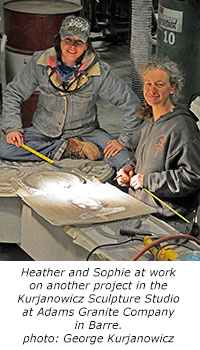
Heather and Sophie at work on another project in the Kurjanowicz Sculpture Studio at Adams Granite Company in Barre (photo: George Kurjanowicz).
|
Heather Ritchie is the first to admit she’s petite. “I’m a tiny creature,” quips the self-possessed 38-year-old from Plainfield. She is standing in the vast manufacturing shed of Adams Granite Company in Barre. Her loose plaid flannel workshirt, baseball cap and steel-toed boots add about as much bulk to her as they would to an Alberto Giacometti sculpture.
It’s hard to imagine that such a creature makes her living carving granite, one of the world’s heaviest types of stone.
Yet Ritchie has not only succeeded in making a living as a granite carver; in the last two years, she has won recognition as a sculptor and artist with three public commissions.
With a grant in 2012 from the Charles Semprebon Fund’s Stone Sculpture Legacy Program for Barre’s public spaces, Ritchie created Coffee Break, a grouping of benches on Main Street sporting the life-sized lunchbox, coffee mug, hand tools and paper hat of 19th-century granite workers.
Continue Reading...
|
|
|
Her Heart and Horizons Widen Art
Artist Sofia Shatkivsa painted in oil and tempera on silk and tapestry in her native Ukraine. She completed 10 years of university study in art, very happy in her work. Then the borders of the country opened and like many others at the time, she was curious about seeing more of the world. It was finally possible. “It was a time when the Berlin Wall was coming down, and when the gates opened, people were ready for that, ” she says about her decision.
Jump to Feature...
|
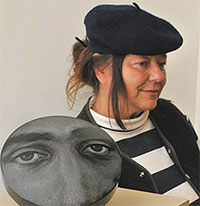
Artist Sofia Shatkivsa (photo:Jan Doerler) |
|
| Barbara Zucker — Sculptor on the Edges of Time |
| by Suzanne Gillis |
|
Vermont Woman was recently invited for a private tour and conversation with Burlington sculptor Barbara Zucker. The massive scale of Zucker’s private studio provides the physical work space that she requires to conceptualize, create and produce individual sculptures or a whole series of sculptures as she has done most recently. These grow from her self-realization as a woman, and it is clear she is an artist who lives with fierce sensitivity, intensity and awareness of a cultural landscape that both idolizes and victimizes femininity.
Barbara Zucker is a graduate of the University of Michigan and has an M. A. in sculpture from Hunter College. She is one of the founders of A. I.R Gallery in New York City, the first all-female cooperative women’s art gallery in the U. S., begun in 1972.
Zucker’s work has been widely exhibited, including in solo shows at Robert Miller Gallery, Artists Space, Sculpture Center, Tufts University, Pam Adler Gallery, Moore College of Art and the Pennsylvania Academy of the Fine Arts. Her work is also placed in collections at the Whitney Museum, the Brooklyn Museum, the Philadelphia Museum of Art, Hebrew Union College Museum and others.
Continue Reading...
|
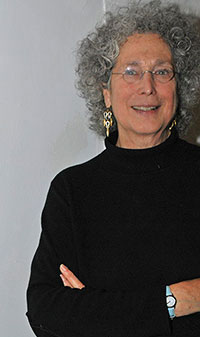
Photo: Jan Doerler |
|
| Adventurer Jan Reynolds says Women Have More than They Think |
| by Sarah Galbraith |
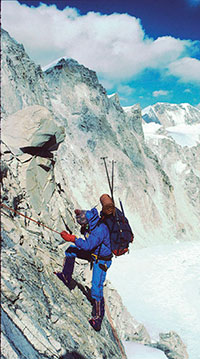
|
Jan Reynolds, of Stowe, Vermont, has always been one of the guys, from growing up on a dairy farm with six siblings, to participating in male-dominated mountaineering expeditions, to parenting two sons. But it was through being one of the guys, she says now, that she learned what it is to be a woman.
An author of 17 books for children and adults, Reynolds’ 2013 work, High Altitude Woman: From Extreme Sports to Indigenous Culture; Discovering the Power of the Feminine (Inner Traditions) chronicles her lifelong career of mountaineering and biathlon adventure.
In college she helped lead the UVM women’s Nordic ski team to a 1978 Division I National Championship, and she spent time on a women’s biathlon team. She held the women’s high altitude skiing record and was part of a team that flew a hot-air balloon over Mt. Everest, setting the altitude record there, too. She has been a member of expeditions to China, Tibet, Nepal, New Zealand, Australia, Lapland, the Amazon Basin, Canadian Arctic, Mongolia and the Sahara.
Continue Reading...
|
|
Vermont Colleges Explore the Future of Women’s Studies |
| by Elayne Clift |
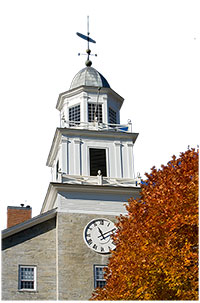 |
Women’s Studies programs, as they have traditionally been called, are currently part of the curriculum at three Vermont colleges and the University of Vermont (UVM). While the programs vary in size and structure, they are all dedicated to the belief that the subject makes a measurable contribution in both academic settings and the wider world.
By the time the first Women’s Studies course in the country was offered in 1969, at Cornell University, feminist scholars and activists had been debating the history, experience and perspectives of women for some time. Concerned about the power inequalities and stereotypical assumptions about women that prevailed, a constituency for women’s rights and a movement called second-wave feminism had begun.
Continue Reading...
|
|
| Dr. Trixie: Wet and Wild |
| by Katharine Hikel, M.D. |

|
Women are pissed off—so to speak— about lack of discussion of a problem that is causing a lot of grief. A visitor to the Vermont Woman website writes:
I would like to encourage you to do an article on pelvic organ prolapse, a widespread problem for women, which includes but is not synonymous with incontinence. There is an appalling lack of comprehensive information addressing and integrating medical and non-medical options for women who want to remain healthy and active with POP...
...Right on, sister. Here we go. But first, some ancient history.
Continue Reading...
|
|
| Screwnomics: The "Informal Economy” Is Why We’re So Tired |

Click here to see the comic.
|
|






